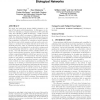Free Online Productivity Tools
i2Speak
i2Symbol
i2OCR
iTex2Img
iWeb2Print
iWeb2Shot
i2Type
iPdf2Split
iPdf2Merge
i2Bopomofo
i2Arabic
i2Style
i2Image
i2PDF
iLatex2Rtf
Sci2ools
ATAL
2003
Springer
2003
Springer
A multi-agent system for the quantitative simulation of biological networks
We apply the multi-agent system (MAS) platform to the task of biological network simulation. In this paper, we describe the simulation of signal transduction (ST) networks using the DECAF [9] MAS architecture. Unlike previous approaches that relied on systems of differential equations (DE), the distributed framework of MAS scales well and allows us to model large, highly interconnected ST pathways. This scalability is achieved by adopting a hybrid strategy that factors macro-level measures, such as reaction rate constants, to calculate the stochastic kinetics at the level of individual molecules. Thus, by capturing the ST domain at an iate level of abstraction, we are able to retain much of the granularity afforded by a purely individual-based approach. The task distribution within a MAS enables us to model certain physical properies, such as diffusion and subcellular compartmentalization, which have proven to be difficult for DE systems. We demonstrate that large-grained agents a...
| Added | 06 Jul 2010 |
| Updated | 06 Jul 2010 |
| Type | Conference |
| Year | 2003 |
| Where | ATAL |
| Authors | Salim Khan, Ravi Makkena, Foster McGeary, Keith S. Decker, William Gillis, Carl Schmidt |
Comments (0)

